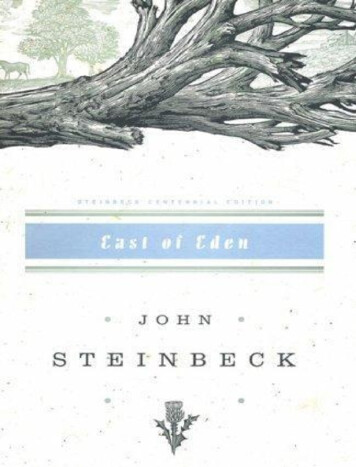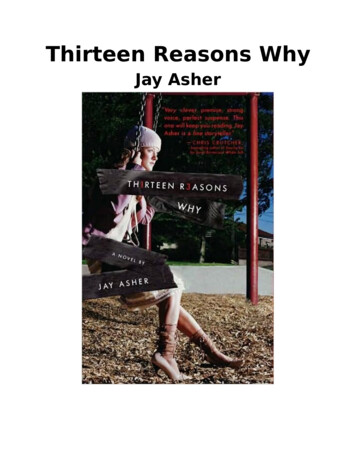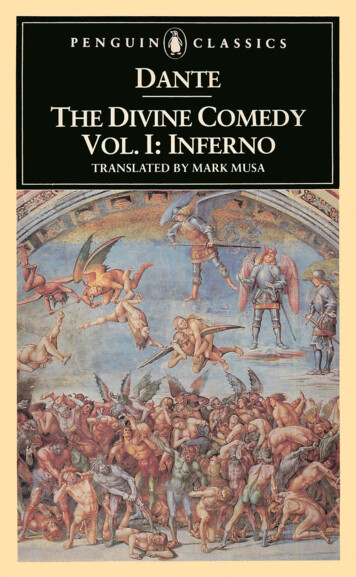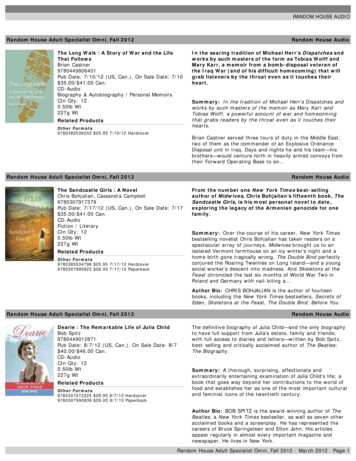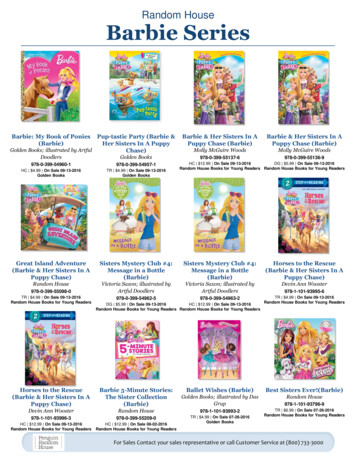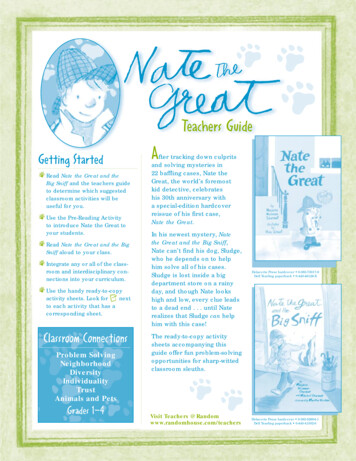
Transcription
Teachers GuideGetting Startedc Read Nate the Great and theBig Sniff and the teachers guideto determine which suggestedclassroom activities will beuseful for you.c Use the Pre-Reading Activityto introduce Nate the Great toyour students.c Read Nate the Great and the BigSniff aloud to your class.c Integrate any or all of the classroom and interdisciplinary connections into your curriculum.c Use the handy ready-to-copyactivity sheets. Look for C nextto each activity that has acorresponding sheet.Classroom ConnectionsProblem als and PetsGrades 1–4After tracking down culpritsand solving mysteries in22 baffling cases, Nate theGreat, the world’s foremostkid detective, celebrateshis 30th anniversary witha special-edition hardcoverreissue of his first case,Nate the Great.In his newest mystery, Natethe Great and the Big Sniff,Nate can’t find his dog, Sludge,who he depends on to helphim solve all of his cases.Sludge is lost inside a bigdepartment store on a rainyday, and though Nate lookshigh and low, every clue leadsto a dead end . . . until Naterealizes that Sludge can helphim with this case!Delacorte Press hardcover 0-385-73017-9Dell Yearling paperback 0-440-46126-XThe ready-to-copy activitysheets accompanying thisguide offer fun problem-solvingopportunities for sharp-wittedclassroom sleuths.Visit Teachers @ Randomwww.randomhouse.com/teachersDelacorte Press hardcover 0-385-32604-1Dell Yearling paperback 0-440-41502-0
PRE-READING ACTIVITIESPrepare your students to participate in solving Nate’s latest case in Nate the Great and theBig Sniff by creating a “Mystery Madness” atmosphere in your classroom. Set the sceneby having students color and display the Magnifying Glass and Detective Hat cutouts C.Ask them to think about the kinds of stories that might incorporate these two items.Write “What is a mystery?” on the blackboard. Help students to define this term and toidentify different types of mysteries (e.g., scientific mysteries, crime mysteries, etc.). Askstudents to give examples of their favorite mystery books, movies, or TV programs andto explain why they like them. If possible, invite a police officer to explain proceduresused in solving a crime and to demonstrate how investigators dust for fingerprints.CLASSROOM CONNECTIONSProblem Solving—Using “Tips on How to Be a Great Detective” in Nate the Great and Me(p. 54) as a guide, introduce students to elements of problem solving. Engage them inclassroom games, such as “concentration” or “memory,” designed to test their ability torecall details, and other activities that will test their observational and analytic skills. TheShow Nate the Way to the Fleeing Fang! maze C andthe Spotting a Disguise and Unscrambling a Secret Codeactivities provided in Nate the Great and Me (pp. 56–58)are perfect for these purposes.Neighborhood—Nate’s familiarity with his neighborhood is First, you have to think. Second, it helps to have a helper.I have a great one. Sludge. Butit’s all right if you don’t. You have to remember. You have to notice people,places, and things. You have to look for facts andclues. You have to ask questions. You have to take ideas apartand put them together again. You have to figure out what isimportant. And what isn’t.2a key factor in finding his mother’s Monster Cookies recipe inNate the Great and the Monster Mess and finding Rosamond’smoney box in Nate the Great Goes Down inthe Dumps. Take a walking field trip inwhich students observe and makewritten notes on the makeup ofa neighborhood area or areas.Ask students to identify buildings,streets, parks, and other physicalfeatures unique to theirneighborhood.Working in small groups,students may constructcereal box buildings and trafficlights, street signs, trees, etc.,made from other art materialsto complete a 3-D model oftheir neighborhood.
Diversity—In Nate the Great and the Big Sniff, as in the entire Nate series, we seethat Nate’s neighborhood friends come from diverse ethnic backgrounds. Havestudents define the terms multicultural and multiethnic and identify the differentethnic/cultural groups in their community. Discuss the advantages of having a diversecommunity and how the influences of each group may be evidenced in their neighborhood.Individuality—Although Nate and his friends have a great deal in common, they all possessunique characteristics. In Nate the Great San Francisco Dectective, Nate describes Claudeas “always losing something.” Have students list and discuss distinguishing attributes fordifferent characters in other Nate stories (e.g., Esmeralda is “smart,” Oliver is a “pest”).Ask students to identify those characteristics that help define themselves as individuals.Conclude with a discussion on the value of individual differences.Trust—All of Nate’s friends place their trust in him when they ask him to take theircases. Even Finley, who tests Nate’s skills in Nate the Great and the Phony Clue, comesto trust in Nate as a great detective. Have students define the term trust. Ask them tolist people they trust and mistrust along with the reasons for feeling as they do. Leada discussion that highlights the importance of trust in all our lives.Pets and Animals—The “Smartest Pet Contest” in Nate the Greatand the Fishy Prize and Nate’s reptile experiences in Nate theGreat and the Tardy Tortoise highlight the many differentpets owned by Nate’s friends and neighbors. Using Nate’sAnimal Crisscross C, have students match eachcharacter with his/her different pet. Discuss withthem the general responsibilities of owning a petand those specific to the care of particularanimals. Have studentsNate the Great and thedraw a picture ofMushy Valentinea pet or favoriteanimaland writeNate the Great and theabout the careCrunchy Christmas(Hanukkah, Christmas)each requires.Celebrate theholidays withNate the Great!Nate the Great and theHalloween HuntDetective Tips on previous page fromNate the Great and Me: The Case of the Fleeing Fang 2002 Marjorie Weinman SharmatArt 2002 Marc Simont3
INTERDISCIPLINARY CONNECTIONSArt—Nate’s sense of color blending helps him to find Annie’s picture of Fang in Nate theGreat. Define primary colors and have students search for reds, yellows, and blues in theirclassroom. Using Nate’s Color Wheel C, have students paint primary color sections of theircolor wheels, making sure they put yellow at the top and skip a section between each. Then,after experimenting with mixing colors using their classroom paints, crayons, or food coloring in various ways, have them paint remaining sections of their color wheels with secondary colors, orange, purple, and green, in the correct pieces of the pie.Use the Mosaic Picture Riddle C, featuring a hidden figure from Nate the Great and theStolen Base, for coloring fun. Allow students to create original paintings emphasizing primaryand/or secondary colors. Discuss with them how the colors affect the mood and feeling oftheir paintings.Math—Using folded pieces of paper, demonstrate fractional parts of a whole in halves,thirds, quarters, and eighths. Define numerator and denominator and have students practiceidentifying and naming different fractional parts, adding and subtracting fractions with common denominators. Reinforce learned concepts by having students decode Nate’s FractionHunt Mystery Message C.After reading Nate the Great and the Lost List, have students form small groups to estimatethe cost of each item on Claude’s list (below) and calculate a total. Then, have students goto their local grocery store to determine the exact price of listed items. Discuss discrepancies and determine which group came closest to their estimations.Rosamond’sCat-Pancake Recipe(aka Claude’s Lost Grocery garSalmonLiverRosamond’s Cat-PancakeRecipe from Nate the Greatand the Lost List 2002 Marjorie WeinmanSharmatArt 2002 Marc Simont4Science—In Nate the Great Goes Undercover, Nate concludes that Oliver’s garbage can is raided each nightby a nocturnal animal. Using the library and Internetresources, on page 7, have students identify one ormore physical features enabling these night creaturesto move about in darkness. Compare the sleep habitsof Nate and his friends in Nate the Great and thePillowcase to the habits of nocturnal creatures.Nate learns a great deal about gardens in Nate the GreatStalks Stupidweed and Nate the Great and the TardyTortoise. Have students identify, list, and draw picturesof flowers and weeds that are familiar to them. Explainwhy plants need soil, sun, and water to stay healthy.Plant a windowsill garden in your classroom.Conduct a unit on reptiles after reading Nate the Greatand the Tardy Tortoise. Begin students’research techniques with a trip to thelibrary. Gather books, pictures, andunusual facts. Set up a class reptile
Social Studies—Nate approaches his search in Nate the Great and the Missing Key ina systematic fashion. Introduce students to directional concepts—north, east, south,west—using a compass as an instrument for determining direction. Using school asa base point, have students directionally locate landmarks in their neighborhood.Language Arts—The informal notes written by Nate in Nate the Great and Me and eachof his stories may be used to introduce students to personal letter writing. Have studentswrite a letter to a friend or relative and help them to address envelopes properly andmail their letters. Introduce them to other books in whichletter writing plays an important role.Music—Help students solve the riddle in Nate the Greatand the Musical Note by labeling the lines and spaces of atreble clef musical staff. Have students sing along as youdemonstrate how notes can step up and down the scale.Use the scale to label the white keys on a piano. Explainhow fingers can step up (sharp) or step down (flat) toblack keys.VOCABULARY/USE OF LANGUAGEThroughout the Nate series, Marjorie Sharmat makes frequent use of alliteration, the repetition of initial consonantsounds in words at close intervals. Such phrases as “goodygreen grasshopper” in Nate the Great and the Fishy Prize, or“big, blue bump” in Nate the Great and the Boring Beach Bag,or “stegosaurus stamp” in Nate the Great and the Sticky Casebring pleasure to the ear as they reinforce meaning. Havestudents search for other instances in Nate’s stories. Then,ask them to create their own alliterative phrases.Using Invisible InkTake a second look next timeyou see a blank piece of paper.It may not be as blank as itseems.You may want to leave someoneyou know an invisible message.You will need:1. Lemon juice in a bowl.2. A thin paintbrush.3. White or pink paper.Dip the paintbrush in thelemon juice and write something you don’t want others toread. Wait for the paper to dry.Poof! What you wrote cannot beseen. Or can it? Hold the paperup to a bright light. What youwrote is now visible again!Have students identify and keep track of words that theyare unfamiliar with. Use Nate’s Secret Word Search C toget your class started.Using Invisible Ink fromNate the Great and Me: The Case of the Fleeing Fang 2002 Marjorie Weinman SharmatArt 2002 Marc Simont5
ENJOYADETECTIVE PARTY WITH NATE!Now that your students have shared many of Nate’s mysteries and learned what ittakes to be a detective of the “greatest” kind, allow them to celebrate theirnewly found skills.First, identify each of your students as a “pancake-eating supersleuth” with a NameTag C. Then, following the mystery message format of Rosamond’s letter in Nate theGreat Saves the King of Sweden (p. 4), have students describe something in their classroom. Put all of the messages in a box or a jar, separate your class into two teams, andhave each member draw a message to be solved. Points may be given for each correctanswer and prizes awarded to the winning team.Students will be ready to see fractions at work in the real world as they measure ingredients in the recipes provided in Nate the Great and Me: The Case of the Fleeing Fangand, with supervision, prepare (and eat!) Nate’s pancakes or potato pancakes. As thesupersleuth himself would say, “Come in. Join the party. Have a pancake or two.”Happy Detective Day!Illustration fromNate the Great andMe: The Case of theFleeing Fang byMarjorie WeinmanSharmatArt 2002 MarcSimont6
About the AuthorAbout the IllustratorsBorn in Portland, Maine, in 1928, MarjorieWeinman Sharmat dreamed of becoming awriter. Little did she know that she would bethe author of more than 70 books for childrenof all ages. Another of her childhood dreams,that of becoming a detective, has also beenrealized in her popular Nate the Great series,begun in 1972. Many of Sharmat’s books havebeen Literary Guild selections and chosen asBooks of the Year by the Library of Congress.Several have been made into films for television, including Nate the Great Goes Undercover,winner of the Los Angeles InternationalChildren’s Film Festival Award. Nate the GreatSaves the King of Sweden has been named oneof the New York Public Library’s 100 Titles forReading and Sharing.Born in Paris, France, in 1915, Marc Simonthas given visual life to nearly 100 children’sbooks. Among these are Marjorie WeinmanSharmat’s Nate the Great series, in whichSimont’s cartoon-like illustrations convey, withhumor and charm, the distinct personalities ofa varied cast of characters. Winner of aCaldecott Honor for Ruth Krauss’s Happy Dayin 1950, and the Caldecott Medal for JaniceMay Udry’s A Tree Is Nice in 1955, Marc Simonthas established his place as one of America’sbest-loved children’s illustrators.Martha Weston has illustrated 58 books forkids, 10 of which she also wrote. Her favoritepart of writing and illustrating is creating aworld of her own—generally a goofy one—andfeeling like she’s stepping into it. Weston lives inthe San Francisco area with her husband andtheir two children.Internet ResourcesFor mystery fun, games,and events, visit Kids Lovea Mystery.www.kidsloveamystery.comTo learn fun techniqueswith coloring products, visitCrayola’s Art Techniques sANSWER KEYSHOW NATE THE WAY TO THEFLEEING FANG!Note: Web sites often change, sobe sure to check out the resourcesbefore using with your class.Rosamond’s CatNATE’S FRACTION HUNTMYSTERY MESSAGEstartR E M E M B E R, / G O O D D E T E C T I V E SEAT PANCAKES!To learn how to use a compass,go to Kjetil Kjernsmos’sillustrated guide on How toUse a Compass.www.learn-orienteering.org/oldFor music activity sheet ideas,visit Sharon’s “Tiny Hands”Music Tutorials.www.hinet.net.au/ mvisser/musictutMOSAIC PICTURE RIDDLENATE’S SECRET WORD SEARCHfinishNATE’S ANIMAL asiaFangHexesparrottortoiseSludgerateelNATE’S COLOR WHEELPrimary colors: YELLOW, BLUE, REDSecondary IRED YELLOW ORANGEYELLOW BLUE GREENBLUE RED PURPLE7
Use All These NATE THE GREAT Detective Storiesby Marjorie Weinman Sharmatwith Illustrations by Marc Simont* with Your StudentsNate the GreatNate the Great and the Stolen BaseHardcover 0-385-73017-90-440-46126-XAnimals (Pets), Friendship,Art,Theater0-440-40932-2Sports (Baseball),Animals (Sea life)Nate the Great Goes Undercover0-440-46302-5Night Animals, Birds,Common Childhood Experiencesby Marjorie Weinman Sharmatand Rosalind Weinman0-440-41015-0Animals (Pets), Sleep CustomsNate the Great and the Lost ListNate the Great and the Mushy Valentine0-440-46282-7Friendship, Maps,Wind Currents0-440-41013-4Holidays & Special Days(Valentine’s Day),ArtNate the Great and the Phony Clue0-440-46300-9Responsibility (Logic, Deadlines),Handwriting Analysis,TrustNate the Great and the Sticky Case0-440-46289-4Activities, Crafts & Hobbies (Stamps), DinosaursNate the Great and the Missing Key0-440-46191-XPoetry, Parties, Friendship, Coins, CamouflageNate the Great and the Snowy Trail0-440-46276-2Seasons (Winter), Birthdays, Descriptions,IndividualityNate the Great and the Fishy Prize0-440-40039-2Animals (Pets)Nate the Great Stalks Stupidweed0-440-40150-XActivities, Crafts & Hobbies (Gardening),Animals (Worms)Nate the Great and the Boring Beach Bag0-440-40168-2Friendship,Travel & Vacation (Beach), OceanNate the Great Goes Down in the Dumps0-440-40438-XFriendship, Ecology, Money, NeighborhoodNate the Great and the Halloween Hunt0-440-40341-3Holidays & Special Days (Halloween),Weight MeasurementNate the Great and the Musical Noteby Marjorie Weinman Sharmatand Craig Sharmat0-440-40466-5Art, Music,Theater,Word RiddlesNate the Great and the PillowcaseNate the Great and the Tardy Tortoiseby Marjorie Weinman Sharmatand Craig Sharmat0-440-41269-2Animals (Reptiles), Science & Nature(Flowers, Gardens)Nate the Great andthe Crunchy Christmasby Marjorie Weinman Sharmatand Craig Sharmat0-440-41299-4Holidays & Special Days (Christmas, Hanukkah),Card/Letter WritingNate the Great Saves the King of Sweden0-440-41302-8Foreign Lands (Sweden),TravelNate the Great and Me:The Case of the Fleeing FangIllustrated by Martha Weston0-440-41381-8Problem Solving, Neighborhood, DiversityNate the Great and the Monster MessIllustrated by Martha WestonHardcover 0-385-32114-70-440-41662-0Family, NeighborhoodNate the Great San Francisco Detectiveby Marjorie Weinman Sharmat and MitchellSharmatIllustrated by Martha WestonHardcover 0-385-32605-X0-440-41821-6Travel, FamilyNate the Great and the Big Sniffby Marjorie Weinman Sharmat and MitchellSharmatIllustrated by Martha WestonHardcover 0-385-32604-10-440-41502-0 (Avail. 2/03)Animals (Pets), Neighborhood*Unless otherwise notedAll books are available in paperback editions except where noted.Prepared by Rosemary B. Stimola, Ph.D., professor of children’s literature at City Universityof New York, and editorial and educational consultant to publishers of children’s books.Random House Children’s Books School & Library Marketing1540 Broadway New York, NY 10036BN562 8/02On the Web!Visit our free onlineresource centerwww.randomhouse.com/teachers
PRE-READING ACTIVITIES Prepare your students to participate in solving Nate's latest case in Nate the Great and the Big Sniffby creating a "Mystery Madness" atmosphere in your classroom.Set the scene by having students color and display the Magnifying Glass and Detective Hat cutouts C. Ask them to think about the kinds of stories that might incorporate these two items.



